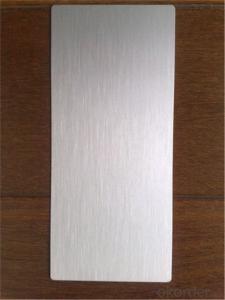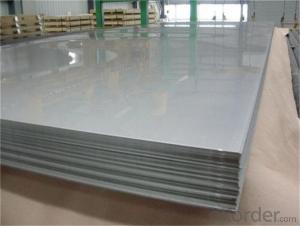8 1/2 X 11 Sheets Aluminum for Inkjet - Aluminum Brazing Sheet for Any Application
- Loading Port:
- China Main Port
- Payment Terms:
- TT OR LC
- Min Order Qty:
- -
- Supply Capability:
- -
OKorder Service Pledge
OKorder Financial Service
You Might Also Like
Aluminium alloys with a wide range of properties are used in engineering structures. Alloy systems are classified by a number system (ANSI) or by names indicating their main alloying constituents (DIN and ISO).
The strength and durability of aluminium alloys vary widely, not only as a result of the components of the specific alloy, but also as a result of heat treatments and manufacturing processes. A lack of knowledge of these aspects has from time to time led to improperly designed structures and gained aluminium a bad reputation.
One important structural limitation of aluminium alloys is their fatigue strength. Unlike steels, aluminium alloys have no well-defined fatigue limit, meaning that fatigue failure eventually occurs, under even very small cyclic loadings. This implies that engineers must assess these loads and design for a fixed life rather than an infinite life.
Another important property of aluminium alloys is their sensitivity to heat. Workshop procedures involving heating are complicated by the fact that aluminium, unlike steel, melts without first glowing red. Forming operations where a blow torch is used therefore require some expertise, since no visual signs reveal how close the material is to melting. Aluminium alloys, like all structural alloys, also are subject to internal stresses following heating operations such as welding and casting. The problem with aluminium alloys in this regard is their low melting point, which make them more susceptible to distortions from thermally induced stress relief. Controlled stress relief can be done during manufacturing by heat-treating the parts in an oven, followed by gradual cooling—in effect annealing the stresses.
The low melting point of aluminium alloys has not precluded their use in rocketry; even for use in constructing combustion chambers where gases can reach 3500 K. The Agena upper stage engine used a regeneratively cooled aluminium design for some parts of the nozzle, including the thermally critical throat region.
Another alloy of some value is aluminium bronze (Cu-Al alloy).
Aluminium foil acts as a total barrier to light and oxygen (which cause fats to oxidise or become rancid), odours and flavours, moistness, and germs, it is used broadly in food and pharmaceutical packaging. The purpose of aluminium is to make long-life packs (aseptic processing|aseptic packaging) for drinks and dairy goods, which allows storing without refrigeration. Aluminium foil containers and trays are used to bake pies and to pack takeaway meals, ready snacks and long life pet foods.
Aluminium foil is widely sold into the consumer market, often in rolls of 500 mm (20 in) width and several metres in length.It is used for wrapping food in order to preserve it, for example, when storing leftover food in a refrigerator (where it serves the additional purpose of preventing odour exchange), when taking sandwiches on a journey, or when selling some kinds of take-away or fast food. Tex-Mex restaurants in the United States, for example, typically provide take-away burritos wrapped in aluminium foil.
Aluminium foils thicker than 25 μm (1 mil) are impermeable to oxygen and water. Foils thinner than this become slightly permeable due to minute pinholes caused by the production process.
- Q: how many aluminum ions are present?how many chloride ions are present?what is the mass in grams of one molecule of aluminum chloride?help! i have no clue how to do this i need to know how for my quiz!!!
- You have to remember Avogadro's number: 6.02 x 10^23 Read about it in your text book. It is the number of molecules of any atom that make up 1 mole. 1 mole of a molecule is equal to it's atomic weight in grams. So, the atomic weight of aluminum is 26.9. So, 26.9 grams of aluminum contains exactly 6.02 x 10^23 molecules of aluminum (or 1 mole). What's the molecular weight of aluminum chloride? Well, 26.9 + 3(35.5) = 133.4 the 35.5 is the molecular weight of chloride and there are 3 of them. So, 133.4 grams of aluminum chloride would be 6.02 x 10^23 molecules. We only have 37.2 g. 37.2 g/ 133.4 g per mole = 0.279 moles. 0.279 moles x (6.02 x 10^23 molecules/mole) = 1.68 x 10^23 molecules of aluminum chloride. So, since there is one aluminum per molecule, you have your answer. Just multiply by three to find out how many molecules of chloride are present. Finally, if 133.4g = 6.02 x 10^23 molecules, then 1 molecule = 133.4 / 6.02x10^23 = 22.16 x 10^-23 or 2.216 x 10^-22 Make sure that the periodic table you use for class has the same values (some tables are more simplified then others). Also, make sure that you use the correct number of scientific digits when calculating your answer.
- Q: Are aluminum sheets suitable for signage and advertising?
- Yes, aluminum sheets are highly suitable for signage and advertising purposes. Aluminum is a durable and lightweight material, making it ideal for creating signs that can withstand outdoor weather conditions and transportation. Its resistance to rust and corrosion ensures that the signs will maintain their appearance and functionality over time. Aluminum sheets can be easily cut and shaped into various sizes and designs, making them versatile for different advertising needs. Additionally, aluminum's smooth surface allows for high-quality printing and graphics, providing excellent visibility and readability for signage. Overall, with its durability, versatility, and aesthetic appeal, aluminum sheets are a practical and effective choice for signage and advertising.
- Q: Can aluminum sheets be anodized in different finishes?
- Yes, aluminum sheets can be anodized in different finishes. Anodizing is a process that creates a protective oxide layer on the surface of aluminum, and this layer can be colored or finished in various ways to achieve different aesthetic and functional results.
- Q: What is the corrosion resistance of 101 aluminum sheets in saltwater environments?
- The corrosion resistance of 101 aluminum sheets in saltwater environments is generally considered to be quite good. Aluminum is inherently resistant to corrosion, and when exposed to saltwater, it forms a protective oxide layer on its surface that further enhances its resistance to corrosion. This oxide layer acts as a barrier, preventing the saltwater from coming into direct contact with the underlying metal and thus slowing down the corrosion process. However, it is important to note that prolonged exposure to saltwater can still lead to some degree of corrosion over time. Regular maintenance and protective coatings can help to further enhance the corrosion resistance of 101 aluminum sheets in saltwater environments.
- Q: How do aluminum sheets perform in terms of chemical resistance?
- Aluminum sheets generally have good chemical resistance due to the formation of a protective oxide layer on their surface. This oxide layer helps prevent corrosion and protects the aluminum from many common chemicals. However, aluminum can react with certain aggressive acids and alkalis, so it is important to consider the specific chemical environment when assessing its chemical resistance.
- Q: What is the typical corrosion resistance of aluminum sheets?
- The typical corrosion resistance of aluminum sheets is high, thanks to the natural formation of a thin layer of aluminum oxide on the surface, which acts as a protective barrier against corrosion.
- Q: Can aluminum sheets be used for heat sinks in LED lighting?
- Indeed, heat sinks in LED lighting can utilize aluminum sheets. Aluminum possesses remarkable heat conductivity, which renders it a perfect substance for dispersing the heat emitted by LED lights. By employing aluminum sheets as heat sinks, the heat generated by the LED chips is effectively transferred away, thereby averting overheating and extending the lifespan of the LED lighting system. Furthermore, aluminum's lightweight nature, resistance to corrosion, and affordability further contribute to its widespread adoption as a heat sink material in LED lighting.
- Q: What is the weight per square foot of 101 aluminum sheets?
- The weight per square foot of 101 aluminum sheets can vary depending on the thickness of the sheets. Generally, the weight of aluminum is measured in pounds per square foot (lbs/ft²). To determine the exact weight per square foot of 101 aluminum sheets, you would need to know the thickness of each sheet. Once you have the thickness, you can use the density of aluminum, which is approximately 0.098 pounds per cubic inch (lbs/in³), to calculate the weight per square foot.
- Q: Can aluminum plate protect against radiation?
- It can only about radiation, and other materials have not heard of this performance.
- Q: What are the common surface treatments for aluminum sheets used in outdoor applications?
- The common surface treatments for aluminum sheets used in outdoor applications include anodizing, powder coating, and PVDF coating.
Send your message to us
8 1/2 X 11 Sheets Aluminum for Inkjet - Aluminum Brazing Sheet for Any Application
- Loading Port:
- China Main Port
- Payment Terms:
- TT OR LC
- Min Order Qty:
- -
- Supply Capability:
- -
OKorder Service Pledge
OKorder Financial Service
Similar products
Hot products
Hot Searches
Related keywords


























